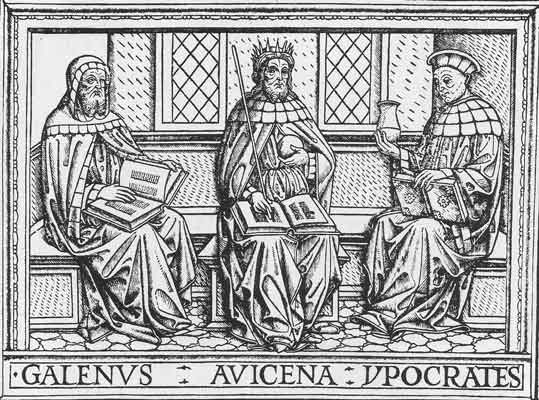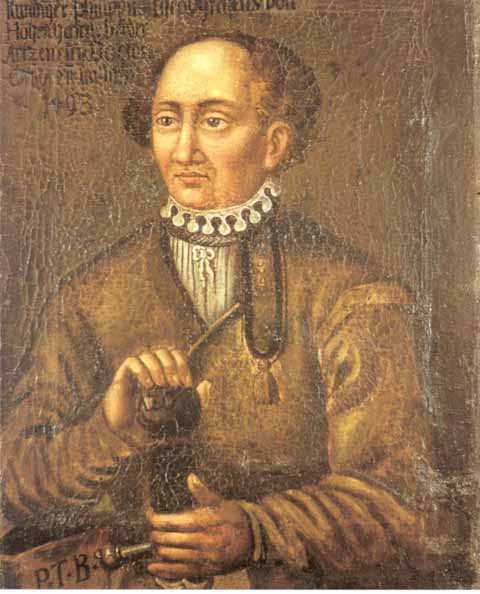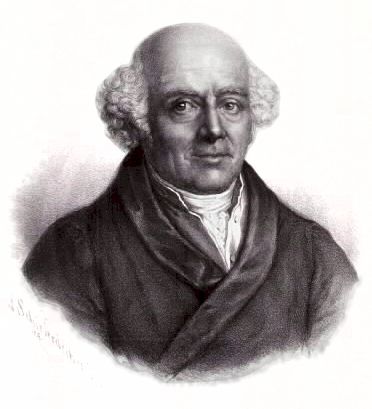
Early history
Homeopathy has a long history, going back to at least the Ancient Greeks. Hippocrates believed that there are two possible types of treatment; administering "contraries" and "similars". 
(HIPPOCRATES)
Aulus Cornelius Celsus (fl. 1st century AD, Rome), was a Roman medical writer, and thought to rely on this same reasoning by some writers. The method of contraries would be followed a century later by Galen of Pergamum (born AD 129, died c. 199). The system of similars was described by philosophers such as Thomas Aquinas and by doctors of the vitalist school of medicine.
One of the most prominent proponents of vitalism who deserves special mention was the Renaissance physician Paracelsus (1493-1541). 
(PARACELSUS)
Paracelsus subscribed to many of the same principles as the modern founder of homeopathy, Samuel Hahnemann. 
(SAMUEL HAHNEMANN)
Vienna physician Anton Freiherr von Störck (1731-1803) and English doctor John Brown (1735-1788) also anticipated the work of Samuel Hahnemann.
Theory of disease in the 18th century
In Hahnemann's day, the conventional theory of disease was based on the four humours. Mainstream medicine focused on restoring the balance in the humours, either by attempting to remove an excess (by such methods as bloodletting and purging, laxatives, enemas and nauseous substances that made patients vomit) or by suppressing symptoms, such as by lowering the body temperature of patients who were feverish. By contrast, Hahnemann promoted an immaterial, vitalistic view of disease, that is, that diseases had spiritual, rather than physical causes.
Vitalism was a part of mainstream science in the 18th century. In the twentieth century, medicine discarded vitalism in favour of the germ theory of disease, following the work of Louis Pasteur, Alexander Fleming, Joseph Lister and many others. Modern medicine sees bacteria and viruses as the causes of many diseases, but Kent and some modern homeopaths regard them as effects, not causes, of disease. Others have adapted to the views of modern medicine by referring to disturbances in, and stimulation of, the immune system, rather than the vital force.
Birth of the modern theory of homeopathy
Samuel Hahnemann conceived of homeopathy while translating the Materia Medica (1789) of the "Scottish Hippocrates" William Cullen into German. On reading that Cinchona bark (which contains quinine) was effective because it was bitter, Hahnemann felt this implausible because other substances were as bitter but had no therapeutic value. To understand the effects of Cinchona bark, he decided to take it himself, and saw that his reactions were similar to the symptoms of the disease it was used to treat. At least one writer has suggested that Hahnemann was hypersensitive to quinine, and that he may have had an allergic reaction.
Yet, this experiment by Hahnemann was by no means unique, as others before him had tried the same approach. For example, Anton von Störck (1731-1803), "in the 1760’s, who advocated treatment by cautious use of poisons." Indeed, Hahnemann had studied briefly in Vienna (1777) where Störck eventually became head of the University. The proving idea had also been recommended by the great Swiss medical botanist, Albrecht von Haller, (1708-77), who Hahnemann admired, and whose Materia Medica he translated in 1806. It might be said the proving experiment came to Hahnemann from several previous sources.
He adopted a reclusive lifestyle while residing in Koethen and his new inclination towards metaphysical pursuits may explain his sudden adoption of [olfaction] (inhaling the remedy), which he continued to use until his death in Paris in 1843. Olfaction might derive from Arabian medicine and the art of perfumery.
The first such homeopathic repertory was George Jahr's "Repertory", published in 1835.
Hahnemann tested many substances commonly used as medicines in his time, such as antimony and rhubarb, and also poisons like arsenic, mercury and belladonna. Hahnemann recorded his first provings of 27 preparations in his book Fragmenta de viribus in 1805. Later, Hahnemann published Materia Medica Pura, which contained provings of a further 65 preparations. He was most heavily engaged in proving in the 1790s and early 1800s, but he never abandoned these experiments. Hahnemann was involved in another phase of proving in preparation for the publication of his books, "Miasm Theory" and "The Chronic Diseases, their Peculiar Nature and their Homœopathic Cure". Miasma Theory and The Chronic Diseases were published in 1828 and contained provings of 48 further preparations.[citation needed]James Kent's Lectures on Homoeopathic Materia Medica (1905) lists 217 remedies, and new substances are continually added to contemporary versions. Homeopathy uses many animal, plant, mineral, and synthetic substances. Examples include natrum muriaticum (sodium chloride or table salt), lachesis muta (the venom of the bushmaster snake), opium, and thyroidinum (thyroid hormone).
The term "homeopathy" was coined by Christian Friedrich Samuel Hahnemann (1755–1843) and first appeared in print in 1807,although he began outlining his theories of 'medical similars' in a series of articles and monographs in 1796.Hahnemann's main opus was the book, The Organon of Medicine. Hahnemann published six editions of this work between 1810 and 1842.
For Hahnemann, the whole body and spirit was the focus of therapy, not just localised disease. Hahnemann spent a lot of time with his patients, asking them not only about their symptoms or illness, but also about their daily lives. This gentle approach contrasted with the violent forms of heroic medicine common at the time, which included techniques such as bleeding as a matter of course.
Nearly as important as Hahnemann to the development of homeopathy was James Tyler Kent (1849 – 1921). Kent's influence in the USA was limited, but in the UK, his ideas became the homeopathic orthodoxy by the end of the First World War. His most important contribution may be his repertory, which is still used today. Kent's attempt to rescue an idealized pure homeopathy from what he saw as its degenerate mongrel forms was authoritarian, as he sought to re-emphasize the metaphysical and clinical aspects of Hahnemann's teachings, in particular:
i.)insistence on the core doctrines of miasm and vital force;
ii.)emphasis on case totality rather than rote prescribing for 'named diseases'
iii.)emphasis on psychological symptoms (to supplement physical pathology) in prescribing; and
iv.)regular use of very high potencies.
v.)Influenced by Swedenborgianism, Kent reputedly emphasized 'spiritual factors' as the root cause of disease.
"...for it goes to the very primitive wrong of the human race, the very first sickness of the human race that is the spiritual sickness... which in turn laid the foundation for other diseases."
Homeopathy history around the world
There are estimated to be more than 100,000 practitioners of homeopathy worldwide, with an estimated 500 million people receiving treatment. More than 12,000 medical doctors and licensed health care practitioners administer homeopathic treatment in the UK, France, and Germany. Homeopathy was regulated by the European Union in 2001, by Directive 2001/83/EC.
Britain
Homeopathy was first established in Britain by Dr Frederick Quin around 1827, though two Italian homeopathic doctors (Drs Romani and Roberta) had been employed two years previously by the Earl of Shrewsbury based at Alton Towers in North Staffordshire; however, they soon returned to Naples as they could not tolerate the cool damp English climate. Homeopathy in the UK quickly became popular with the aristocracy, and Quin counted among his patients, the Dukes of Edinburgh and Beaufort and the Duchess of Cambridge.
At its peak in the 1870s Britain had numerous homeopathic dispensaries and small hospitals as well as large busy hospitals in Liverpool, Birmingham, Glasgow, London and Bristol, almost exclusively funded and run by members of the local gentry.
In Britain, homeopathic remedies are sold over the counter. Today Britain has five homeopathic hospitals, funded by the National Health Service, which together with many regional clinics make free homeopathic treatment available on the health service. Homeopathy is not practised by most of the medical profession, but it enjoys support from the Prince of Wales and many other members of the royal family.
The largest organisation of homeopaths in Britain, the Society of Homeopaths, was founded in 1978 and has been growing steadily since then; it now has 1300 members, an increasing proportion of whom are women. Homeopaths in Britain are represented by the Faculty of Homeopathy, incorporated by an Act of Parliament in 1950, and based in London.
India
Homeopathy arrived in India with Dr John Martin Honigberger (1795-1869) in Lahore, in 1829-30,and is officially recognized. "The first doctor who brought homeopathy to India was Dr. Martin Honigburger, who first came to the Punjab...in 1829." India has the largest homeopathic infrastructure in the world, with 300,000 qualified homeopaths, 180 colleges, 7500 government clinics, and 307 hospitals. The Association of Qualified Homoeopaths in India (IHK) is the largest of its kind.
USA
Homeopathy was first practiced in the USA by Dr Hans Burch Gram in 1825 and rapidly gained popularity, partly because the lack of availability of conventional medicine, and partly due to the efforts of Dr Constantine Hering, who immigrated to the US in 1833, and was later called "the father of American homeopathy". By the early 1840s homeopathy enjoyed considerable influence and prestige, and in the period 1880 - 1900 reached the height of its popularity. Use of homeopathy has since declined in the US, and as of 2002 about 1.7% of people polled reported having sought homeopathic treatment.
Waning of popularity
In the 1930s homeopathy's popularity waned, especially in the USA and Europe, due in part due to advances in conventional medicine, skepticism, and the active advocacy against homeopathy by the American Medical Association. This led to the closure of virtually all medical schools teaching alternative medicine in the USA.
Homeopathy reached a peak of popularity in 1865–1885 and thereafter declined due partly to recognition by the establishment of the dangers of large doses of drugs and bleeding, and via dissent between different schools of homeopathy. The Carnegie Foundation issued the Flexner Report sponsored by the American Medical Association in 1910 that supported conventional medical schools while condemning homeopathic schools.
The Federation of State Medical Boards voluntarily agreed to base its accreditation policies for all medical schools on academic standards determined by the AMA's Council on Medical Education. Consequently, the CME's decisions "came to have the force of law." By the 1930s, the combined efforts of state licensing boards, philanthropic foundations, and the AMA's CME resulted in the eradication of America's proprietary medical colleges including homeopathic schools.
Classical versus non-classical homeopathy
Hahnemann's formulation of homeopathy is often referred to as classical homeopathy. Classical homeopaths use one remedy at a time, and base their prescription also on incidental or constitutional symptoms. However, homeopathic remedies are often used both by practitioners and by the public based on formulations marketed for specific medical conditions. Some formulations use a 'shotgun' approach of the most commonly indicated single remedies in mixture form, while others, such as those by Heel and Reckeweg, are proprietary mixtures marketed for specific diagnostic criteria based on various systems. Many members of the public are unfamiliar with classical homeopathy, and equate these practices with homeopathy; others are familiar with the classical approach but regard these as legitimate variants; while others consider it a misuse of the term. Use of non-classical approaches is confined mainly to places where over-the-counter preparations are popular and where many doctors use natural medicines in a conventional clinical setting.
Sunday, August 26, 2007
HISTORY OF HOMEOPATHY
Posted by
Dr. Mohideen Badhusha
at
1:03 PM
![]()
Labels: Homeopathy History
Subscribe to:
Post Comments (Atom)












5 comments:
Homeopathy
The new age medicine..
To know more about the doctors
and treatments in India
Log on to http://homeopathyzone.googlepages.com/
Hi,
I am The editor/writer with medicine-worldwide.net. I really liked your site and i am interested in building a relationship with your site. We want to spread public awareness. I hope you can help me out. Your site is a very useful resource.
Please email me back with your URL in subject line to take a step ahead and also to avoid spam.
Thank you,
Maria Jones
maria.medicineworld@gmail.com
www.medicine-worldwide.net
Nice post..I have gone through your blog. The information you have given are really informative.
Homeopathy Clinic in Mohali
A very thought provoking post and resonates with me.
Piles Treatment In Hyderabad
Post a Comment